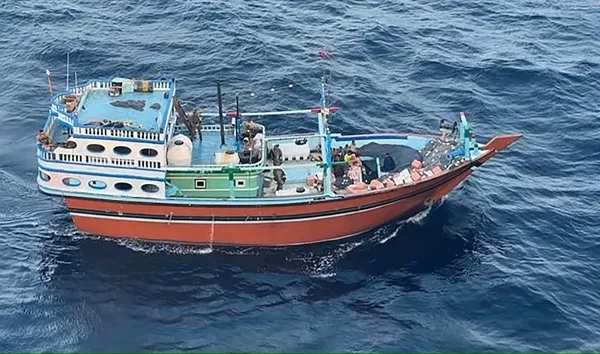(NEW YORK) — The two U.S. Navy SEALs missing in the Gulf of Aden off Somalia were on a mission to board a dhow that led to the seizure of Iranian-made ballistic and cruise missile components headed to Houthi militants in Yemen, according to U.S. Central Command.
The risky nighttime mission last Thursday to board the dhow in rough waters continued even after one of the SEALs fell into the water and the second SEAL, following protocol, jumped into the water to rescue his teammate.
Search and rescue operations for the two missing SEALs are continuing in the Gulf of Aden with U.S. Navy aircraft and ships participating in the search.
For years the U.S. Navy has intercepted dhows, the name for small fishing or cargo vessels used in the region, believed to be carrying Iranian-made weapons to the Houthis.
During these missions, boarding teams typically pull aside the dhows to undertake a “flag verification” mission if the dhow is unflagged or has replaced its flag to mask their smuggling mission.
This latest seizure was the first since the Houthis began to carry out the more than 30 drone and missile attacks on commercial shipping in the Red Sea, most of which have been repelled by U.S., French, and British warships.
On Thursday, Jan. 11 “Navy forces conducted a night-time seizure of a dhow conducting illegal transport of advanced lethal aid from Iran to resupply Houthi forces in Yemen as part of the Houthis’ ongoing campaign of attacks against international merchant shipping,” said a CENTCOM statement.
The SEALs were operating from the expeditionary sea base USS Lewis B Puller (ESB 3), a converted freighter topped with landing decks for helicopters and capable of releasing small watercraft used by SEALs when they approached the dhow.
With helicopters and drones flying overhead they “executed a complex boarding of the dhow near the coast of Somalia in international waters of the Arabian Sea seizing Iranian-made ballistic missile and cruise missiles components.”
They included components for propulsion, guidance, and warheads for Houthi medium range ballistic missiles and anti-ship cruise missiles, as well as air defense associated components.
“Initial analysis indicates these same weapons have been employed by the Houthis to threaten and attack innocent mariners on international merchant ships transiting in the Red Sea,” said CENTCOM.
The seizure marked the first time since November, 2019 that the U.S. Navy has seized Iranian-made ballistic missile and cruise missile components headed for the Houthis.
Nighttime ship boardings by boat, carried out in pitch black, are some of the most difficult missions that a SEAL can undertake and require constant training according to a retired SEAL commander
“You have the the risk of of your boat capsizing in close proximity to larger vessels, you have to establish a solid ladder point, you have to climb a ladder at night over the open ocean between two ships, they’re smashing into each other, and then get on board,” said Eric Oehlerich, an ABC News contributor.
“And then your problem starts with what you’re going to do it with whomever is on board that boat,” he added.
Oehlerich said the risk to SEALs undertaking these missions in the Gulf of Aden and the Somali Basin increases during this time of year when ocean waves are especially high.
“In the wintertime, the sea state is typically eight to 12 feet,” said Oehlerich. “The horizon is flat, so 8-12 feet is eight feet above the flat horizon, and then eight feet, it’s like a 16 foot wave.”
After the dhow’s seizure it was deemed unsafe and sunk by U.S. naval forces, the fate of the 14 crewmembers is still to be determined.
“It is clear that Iran continues shipment of advanced lethal aid to the Houthis. This is yet another example of how Iran actively sows instability throughout the region in direct violation of U.N. Security Resolution 2216 and international law,” said CENTCOM commander Gen. Michael Erik Kurilla,
“We will continue to work with regional and international partners to expose and interdict these efforts, and ultimately to reestablish freedom of navigation,” he added.
Copyright © 2024, ABC Audio. All rights reserved.

